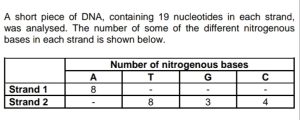Life Science 2022 Paper2 November SECTION A 1.1
Activity Summary
0 of 9 Questions completed
Questions:
Information
You have already completed the activity before. Hence you can not start it again.
Activity is loading…
You must sign in or sign up to start the activity.
You must first complete the following:
Results
Results
0 of 9 Questions answered correctly
Your time:
Time has elapsed
You have reached 0 of 0 point(s), (0)
Earned Point(s): 0 of 0, (0)
0 Essay(s) Pending (Possible Point(s): 0)
| Average score |
|
| Your score |
|
Categories
- Life Sciences Grade 12 0%
| Pos. | Name | Entered on | Points | Result |
|---|---|---|---|---|
| Table is loading | ||||
| No data available | ||||
- 1
- 2
- 3
- 4
- 5
- 6
- 7
- 8
- 9
- Current
- Review / Skip
- Answered
- Correct
- Incorrect
-
Question 1 of 9
1. Question
1.1 Various options are provided as possible answers to the following questions.
Choose the answer and write only the letter (A–D) next to the question
numbers (1.1.1 to 1.1.9) in the ANSWER BOOK, e.g. 1.1.10 D.
This is how your instructions will be in the exam. For this exam practice, just select the correct answer.
1.1.1
The scientist who discovered the fossil ‘Karabo’ (A. sediba):CorrectIncorrect -
Question 2 of 9
2. Question
1.1.2
Which ONE of the following is a source of variation that occurs
during normal meiosis?CorrectIncorrect -
Question 3 of 9
3. Question
1.1.3
How many sex chromosomes does a normal human female inherit
from her mother?CorrectIncorrect -
Question 4 of 9
4. Question
1.1.4
During which phase of meiosis does the nuclear membrane
disappear?CorrectIncorrect -
Question 5 of 9
5. Question
1.1.5
Which ONE of the following is an example of discontinuous
variation in humans?CorrectIncorrect -
Question 6 of 9
6. Question
1.1.6
For a particular characteristic, the offspring inherits …CorrectIncorrect -
Question 7 of 9
7. Question
1.1.7
Which ONE of the following is CORRECT for speciation through
geographic isolation?CorrectIncorrect -
Question 8 of 9
8. Question
1.1.8
Below is a list of events that occur during cell division
(i) Homologous chromosomes line up at the equator of the cell.
(ii) Chromatids are pulled to opposite poles of the cell
(iii) Chromosome pairs arrange themselves randomly at the
equator of the cell.
(iv) Individual chromosomes line up at the equator of the cell.Which ONE of the following combinations occur in both meiosis
and mitosis?CorrectIncorrect -
Question 9 of 9
9. Question
1.1.9

How many nucleotides containing thymine (T) were present in
strand 1?CorrectIncorrect

